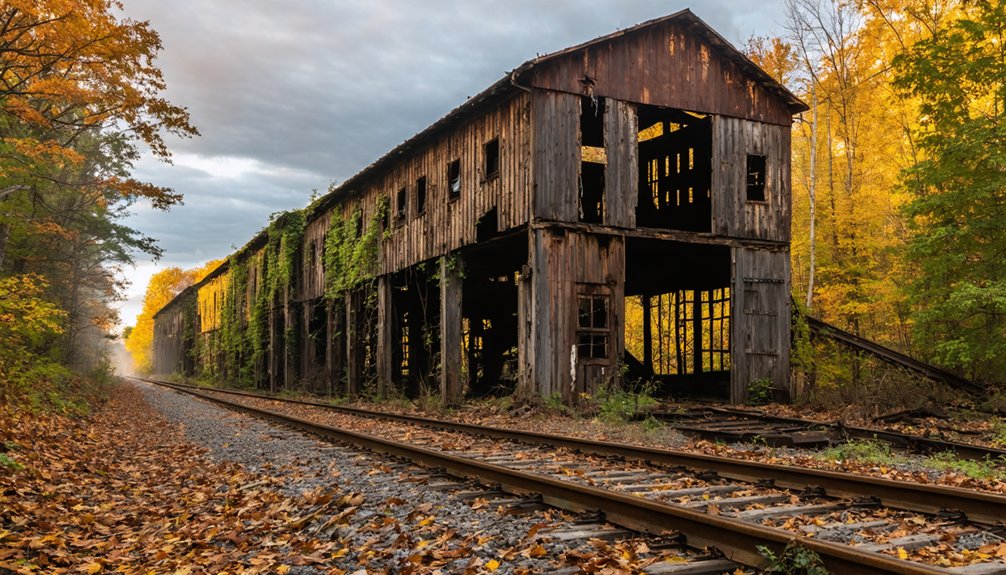You’ll discover abandoned settlements throughout Tippecanoe County, Indiana, where frontier towns like Little Chicago and Harrisonville once flourished. These ghost towns emerged in the 1830s around Quaker meetinghouses and trading posts, with essential connections to Native American communities and Underground Railroad operations. Today, only scattered remnants remain – a modernized house in Little Chicago, hidden cemeteries, and deteriorating structures that hold centuries of pioneer stories waiting to be uncovered.
Key Takeaways
- Little Chicago, a former Tippecanoe County settlement, has dwindled to a single modernized house and is considered a ghost town.
- Early settlements like Harrisonville vanished, with only scattered cemeteries near Yorktown remaining as evidence of pioneer life.
- Prophetstown, once a thriving Native American settlement, became a ghost town after military campaigns in the 1830s.
- Underground Railroad hideouts and historic Quaker structures are deteriorating, slowly transforming former communities into abandoned sites.
- The 1876 Illustrated Historical Atlas helps locate vanished settlements in Tippecanoe County that have become ghost towns.
The Rise and Fall of Historical Settlements
While French trader Burnett established the first European presence in Tippecanoe County at Stringtown, it wasn’t until the 1820s that organized settlements began taking root throughout the region.
Early cultural exchanges centered around trading posts and ferry crossings, with pioneers like John Davis forming connections through marriage to Native American families.
Trading posts and river crossings brought cultures together, as settlers like Davis bridged communities through Native American marriages.
The settlement dynamics shifted dramatically after the Battle of Tippecanoe in 1811, opening the floodgates for European-American migration.
You’ll find that villages like Harrisonville and Little Chicago emerged in the 1830s, anchored by Quaker meetinghouses and blacksmith shops. The Underground Railroad played a significant role in Little Chicago’s history, with residents like Buddell Sleeper supporting the cause.
Like the later wagon building ventures of the Studebaker brothers in 1852, these early settlements relied heavily on skilled craftsmen and trade.
These communities initially thrived through self-sufficiency and strong local ties. However, as transportation networks evolved and economic patterns changed, many smaller settlements couldn’t sustain themselves.
They were either absorbed by larger towns like Battle Ground or faded into obscurity.
Native American Roots and Cultural Heritage
Before European settlers arrived in Tippecanoe County, the region thrived as a cultural crossroads for numerous Native American nations, including the Miami, Shawnee, and Illinois tribes.
You’ll find that Prophetstown emerged as a powerful symbol of Indigenous resilience in 1808, uniting roughly 3,000 Native Americans under Tecumseh and his brother Tenskwatawa’s leadership.
The settlement became more than just a village – it stood as an intertribal stronghold where Native American traditions flourished.
Tenskwatawa’s spiritual teachings called for rejecting European influences while preserving indigenous customs.
However, the 1809 Treaty of Fort Wayne, which ceded three million acres of Native land, sparked fierce resistance.
The forced relocation policies of the 1830s would later devastate many peaceful tribes in the region, despite their non-involvement in earlier conflicts.
Despite the confederation’s determined efforts, subsequent military campaigns and forced relocations devastated Native communities, eventually turning this once-vibrant cultural center into a ghost town. The battle that sealed Prophetstown’s fate came when Governor William Harrison launched an attack that would ultimately destroy the settlement.
Battle Legacy and Military Influence
The Battle of Tippecanoe on November 7, 1811, permanently altered the region’s military and political landscape.
As you walk the grounds today, you’ll find evidence of the battle impact in the 85-foot marble obelisk that stands as a memorial to this pivotal conflict. The military strategies employed here – from Harrison’s quadrangular camp formation to the militia’s irregular rectangular formations – would influence future frontier warfare. The discovery of British supplied arms at the battle site heightened tensions between the United States and Great Britain.
You can still trace the footsteps where approximately 1,000 American troops fought against Native American forces in a bloody two-hour engagement. The Yellow Jacket riflemen suffered the heaviest losses during the battle, with nearly all their officers killed.
The battle’s outcome crushed Tenskwatawa’s influence and weakened Tecumseh’s confederacy, clearing the way for increased settlement. This victory launched William Henry Harrison‘s path to the presidency and solidified American control over the Indiana Territory.
Quaker Communities and Early Pioneers
While most of Tippecanoe’s early settlements have vanished, you’ll still find the enduring legacy of the Farmer’s Institute Quaker community through its preserved meeting house and cemetery.
The Browns, Sleepers, and other Quaker families established this settlement in the mid-1800s, creating a hub of anti-slavery activity and agricultural innovation. These pioneering families traveled together collectively to build new lives along the Tippecanoe River.
You can trace the community’s influence through the meeting house’s recorded activities, which document everything from marriage ceremonies to Underground Railroad operations that helped freedom seekers escape to the North. One significant site was the Buddell Sleeper House, which served as a safe haven station for those seeking freedom.
Farmer’s Institute Legacy Lives
Following the War of 1812, vast numbers of Quaker pioneers migrated from the Carolinas, Tennessee, and Ohio to establish new communities in Indiana, with Farmer’s Institute emerging as a significant settlement in Tippecanoe County.
The community’s resilience shone through its landmark achievements, including the establishment of the area’s first school of higher learning in 1851.
You’ll find evidence of their educational impact in the school building that still stands today, a reflection of the Quakers’ dedication to learning and growth.
The settlement’s progressive values were demonstrated by their welcome of the African American Chambers family and the courageous Underground Railroad activities of Buddell and Betsy Sleeper.
Though Farmer’s Institute is now considered a ghost town, its legacy of education, equality, and community spirit lives on through historical markers and local memory.
Like many Quaker social movements, the community actively supported both education and abolitionist causes during the mid-1800s.
Early Meeting House Activities
During the early 1800s, Quaker meeting houses emerged as essential centers of spiritual and social life throughout Tippecanoe County, with carefully structured gatherings that reflected their commitment to order and equality.
You’d find a distinctive meeting structure inside these timber-frame buildings, where a raised platform accommodated elders and ministers who’d address the congregation. The seating arrangement strictly divided men and women to opposite sides of the room.
Beyond worship, you’ll discover these meeting houses served as crucial hubs for business meetings and community activities. They’re where you’d witness the meticulous record-keeping of births, deaths, marriages, and removals – documents that have become invaluable historical treasures. The establishment’s vibrant first school of learning opened in 1851, marking a significant advancement in local education.
These spaces fostered both spiritual growth and social bonds, creating a foundation for the tight-knit Quaker communities that shaped Tippecanoe County’s early development.
Lost Landmarks and Forgotten Places

If you’re searching for the ghostly remnants of Tippecanoe’s past, you’ll find few original structures remaining besides the 1851 Quaker Farmer’s Institute building and a remodeled house from Little Chicago.
Along the landscape where pioneer settlements once thrived, you’ll discover only scattered cemeteries near Yorktown and historical markers commemorating lost communities like Pigeon Roost.
The county’s transformation has left minimal physical evidence of its early settlements, with many landmarks demolished or deteriorated beyond recognition, though the Tippecanoe Battlefield Park preserves artifacts and memorials from the period.
Historical Structures Vanishing Today
The once-thriving historic structures of Tippecanoe’s ghost towns are rapidly disappearing from Indiana’s landscape, leaving behind mere fragments of the county’s rich past.
You’ll find Little Chicago’s bustling community, established in 1835, now reduced to a single modernized house where stores and a blacksmith shop once stood.
Historic preservation efforts face mounting challenges as original barns and salt houses succumb to demolition or repurposing, diminishing architectural authenticity throughout the region.
Even the Underground Railroad‘s secret hideaways are vanishing beneath modern renovations.
While Quaker-built schools and meeting houses from the mid-1800s still stand, they’re slowly deteriorating.
Your best chance of connecting with this vanishing history lies in the area’s cemeteries, which remain as silent witnesses to early settler life, though many fall into neglect.
Mapping Abandoned Settlement Locations
Mapping Tippecanoe County’s vanished settlements demands meticulous detective work, as these forgotten communities now exist primarily in yellowed maps and fading memories.
For accurate ghost town mapping, you’ll need to rely on multiple historical sources while cross-referencing modern locations.
Key settlement documentation tools include:
- The 1876 Illustrated Historical Atlas, revealing landowner names and essential landmarks
- Local newspaper archives, particularly the Lafayette Journal and Courier
- Cemetery records and surviving church buildings like the Farmer’s Institute
You’ll find Little Chicago’s last remnants near Country Road 750 S., while other lost communities like Sugar Grove and Wheeler’s Grove have virtually disappeared.
Most sites now lie beneath farm fields or suburban developments, making precise location identification challenging without extensive archival research.
Supernatural Tales and Modern Mysteries
Supernatural tales surrounding Tippecanoe’s ghost towns weave together Native American spirituality, battlefield hauntings, and modern paranormal encounters.
You’ll find reports of ghostly apparitions near the ruins of Prophetstown, where the echoes of the 1811 battle still linger. Residents near Little Chicago and Harrisonville share stories of supernatural encounters, from shadowy figures to unexplained voices along the riverbanks.
The area’s strongest paranormal activity centers around former Underground Railroad hideouts and Native American burial grounds.
You might hear whispers of Tecumseh’s confederation spirits or encounter electromagnetic anomalies near the battlefield memorial. Local paranormal investigators document cold spots and moving objects in buildings that stand on former settlement sites, while the rivers hold their own mysteries of spectral warriors and protective ancestral energies.
Frequently Asked Questions
What Was the Average Population of Tippecanoe During Its Peak Years?
You’ll find historical records suggest a peak population of roughly 150-200 residents during Tippecanoe’s most active period, though its historical significance extends beyond these limited demographic figures.
Were There Any Natural Disasters That Contributed to Tippecanoe’s Decline?
Despite searching through historical records spanning centuries, you won’t find evidence of flood damage or drought effects contributing to Tippecanoe’s decline. Military conflicts and human actions were the primary causes.
What Happened to the Original Town Records and Documents?
You won’t find most of Harrisonville’s original archives, as no formal preservation system existed. Records were likely scattered or lost during the town’s absorption into Battle Ground and municipal changes.
Did Any Famous People Besides William Henry Harrison Visit Tippecanoe?
You’ll find notable historical figures like Tecumseh, his brother Tenskwatawa (The Prophet), Quaker settler Buddell Sleeper, and John Burget visited the area, making it a hub for Native American-settler interactions.
What Crops and Industries Sustained the Early Tippecanoe Settlements?
You’d find pioneers thriving on corn, wheat, and oat farming through traditional agricultural practices, while the fur trade, logging, and river transportation along the Wabash River formed the backbone of local industries.
References
- http://ingenweb.org/intippecanoe/ghosttowns.htm
- https://www.youtube.com/watch?v=AjUNOxU5dW0
- http://www.tippecanoehistory.org/wp-content/uploads/TippecanoeHistory.pdf
- https://lostinthestates.com/tippecanoe/
- http://ingenweb.org/intippecanoe/twp.html
- https://www.thislocallife.com/tippecanoe
- https://en.wikipedia.org/wiki/List_of_ghost_towns_in_Indiana
- https://en.wikipedia.org/wiki/Corwin
- http://freepages.rootsweb.com/~gtusa/history/usa/in.htm
- https://notebookofghosts.com/2016/02/25/indiana-cemeteries-tippecanoe-battlefield/



